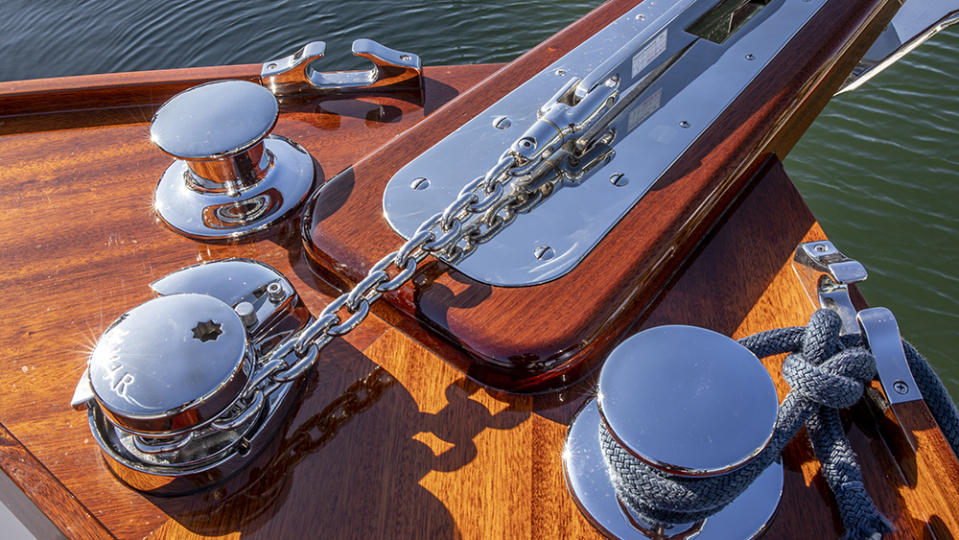The Boating World Has Finally Embraced the Restomod

Compared to their popularity in the car world, restomods—restored classics modified with the latest tech and trim—have arrived late to yachting. “Ten years ago, most boaters didn’t even recognize the term, but we’ve seen it gain legs,” says Bill Morong, owner of Yachting Solutions, a boatyard in Rockport, Maine, which has completed more than a dozen such transformations.
The restoration of older boats typically involves salvaging as many original parts as possible, including engines, for historical accuracy. It’s this authenticity that factors into the judging at shows and buoys standing within the small-but-fastidious classic-boat circles. But things are changing.
More from Robb Report
This New 43-Foot Day Boat Has a Deck That Can Move Above and Below the Water
A Russian Oligarch's $500 Million Megayacht Just Mysteriously Arrived in Hong Kong
“Those boats are quaint but not very practical,” says Morong. “Few people want 1930s gas engines or wire-and-sprocket steering systems; they like boats with the appeal of yesteryear but want modern systems and propulsion. They usually ask us to create something different from the shells of their grandparents’ boats.”
Interestingly, vessels handed down within families comprise the majority of inquiries Yachting Solutions receives, though there can be a tendency to balk at the cost of the restomod process. “I often tell them that the cost of the project, as a rule of thumb, will be more than the cost of a similar-sized new production boat, but less than a new custom project designed from a fresh sheet of paper,” says Morong.

Some rise to the challenge, such as the owner of Avocette. The 1931 Fairform Flyer, built by Huckins, had a number of caretakers who kept it in shipshape condition but was ready for a refresh after nearly 20 years of neglect.
“It was a basket case,” says the owner, noting that, beyond rotting wood, a fire had consumed the interior. In 2016, he decided to return Avocette to its former glory, but with caveats: It had to be safe and comfortable, and its 1930s heritage needed to be preserved. As for the project, “it wasn’t for the faint of heart,” he says. “We made so many decisions, it became a custom design.”
Every element of Avocette required a total rebuild. Morong’s team collaborated with naval architect Bill Prince, using 1930s drawings from Huckins and laser scans. According to Morong, the reimagining entailed reconstructing the hull to fit the new vision, but with “original proportions and shape, so it didn’t look like some bastardized version.”
The process also included moving the new engines aft—the 1931 Sterling Petrel engines were replaced with 450 hp Volvo Penta Diesels with IPS pods—as well as adding a C-Zone digital onboard- management system and repositioning the galley forward to provide a contemporary dining space with a skylight. Then there’s the new salon, highlighted by an Art Deco fireplace and wood-beamed ceilings that reflect the increased headroom throughout.

Most restomods don’t involve 90-year-old donor vessels. Yachting Solutions’ other projects range from a ’63 Bertram 31 to a 2014 Intrepid. The Intrepid’s owner wanted a much higher level of customization than the factory was willing to do, essentially turning a bare fiberglass fishing vessel into a New England–style wood-clad runabout. At the lower end, Metan Marine of Lakeville, Mass., has made a name for itself by reinterpreting 17-foot Boston Whalers from the late 1960s.
Morong also points out that, rather than simply upgrading hidden components like engines, many yards are exercising a wider artistic license over exterior designs. Cooley Marine, in Stratford, Conn., recently finished work on a ’69 Bertram 31, retaining its classic lines but adding a blue-tinted windshield that resembles “a huge pair of Costa sunglasses,” according to founder Andrew Cooley. “We started with the bare hull and tried to install every feature on the owner’s 50-foot Tiara,” he says.
Among the numerous modifications were an updated frame design to support the much heavier windshield, which required hiring a composite engineer, and reconfigured bulkheads for more space. “It’s 100 percent custom and modern but still looks like a Bertram 31,” says Cooley. Which is the exact mission statement of a restomod.
Best of Robb Report
The Chevy C8 Corvette: Everything We Know About the Powerful Mid-Engine Beast
The 15 Best Travel Trailers for Every Kind of Road-Trip Adventure
Sign up for Robb Report's Newsletter. For the latest news, follow us on Facebook, Twitter, and Instagram.

